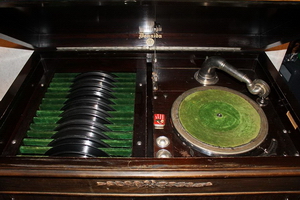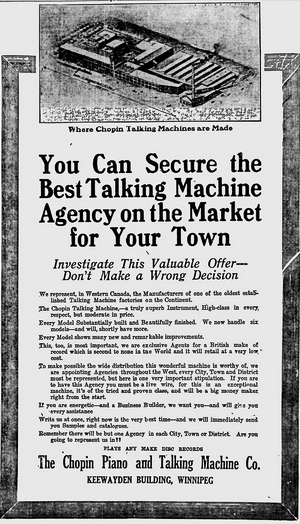|
Donalda: A Canadian Melba?
by Keith Wright

|
|
Pauline Donalda nee Lightstone or Lichtenstein.
Canadian opera singer whose career spanned 1905 to 1922.
Image courtesy Wikimedia Commons, public domain.
|
|
|
As is often cited, the major equipment
patents on phonographs, gramophones
and talking machines began to expire
near the end of WWI. This enabled others—
previously too timid to jump into production,
unlike Pollock of Berlin, Ontario— to enter
the business and compete with Victor/Berliner,
Columbia and Edison. In those days, when
mass transport of goods was not cheap or
convenient, local manufacturers with tangential
expertise sprang up to supply their neighbours,
and perhaps beyond, with machines of various
quality. Thus begat the bewildering number
of companies that are currently listed by the
Canadian Antique Phonograph Project (accessible
directly CAPP or
through the CAPS main page CAPS).
Naturally, we would expect
these companies to be distributed according to
population density, which begins to explain a lack
of representation from provinces west of Ontario.
Until recently.
As is so often the case, this story begins with an
e-mail:
“My mother bought a cabinet gramophone,
around 50 years ago, from a Salvation Army Store
in Winnipeg, Manitoba. It stands on legs, has
storage for records on the left side and a drawer
on the bottom. It is marked with the Hudson Bay
Company Logo on the inside, and also a Donalda
logo as well.
“[signed] Lynn Houde”
Pictures later supplied show a typical console
model with the described Hudson’s Bay Company
and “Donalda” logos. I can’t remember the
precise, “aha” moment but my research started in
two places and fortunately met in the middle.
Pauline Lightstone was born in Montreal in 1882
of Russian and Polish parents who changed
their name from Lichtenstein. She studied music
on a scholarship at the Royal Victoria College.
Her father sought confirmation of her talents,
which was received from French tenor Thomas
Salignac, and allowed her to study opera in Paris
starting in 1902, on a grant from one Donald
Smith, Lord Strathcona. Pauline made her debut
in 1904 at Nice, apparently with the help of
French composer Jules Massenet, and allegedly

|
|
Detail of console “Donalda” model that sparked the research.
Image courtesy Lynn Houde.
|
|
|
to honour her benefactor adopted the stage name
Pauline Donalda (aha?). She made her London
debut at Covent Garden in 1905, her professional
Canadian debut in 1906 and her New York debut
later the same year (after breaking her contract
to accept an offer from Oscar Hammerstein’s
Manhattan Opera Company). The Canadian
Encyclopedia entry makes the rather prescient
comment, “[Donalda was] Considered a rival of
[famous Australian operatic soprano Dame Nellie]
Melba, she often replaced her and thus sang Mimi
with Enrico Caruso.” (An interesting side note
is that Lord Strathcona earlier brought one Clara
Lichtenstein to Canada (no relation), who became
director of music at the Royal Victoria College
and had a profound and lasting effect on Pauline.)
Pauline’s performing career spanned 1905 to
1922, including nine recordings, after which
she turned to teaching and administration. She
opened a studio in Paris in 1922 where she taught
before returning to Montreal in 1937 where she
again opened a studio, then in 1942 founded the
Opera Guild. In 1967 she was made an Officer
of the Order Of Canada and died 3 years later in
Montreal. On the recording side, she cut 7 sides
for G&T in London, 1907 and 1908, one for
Victor in 1914 and one for Emerson around 1916.

|
|
Donald Alexander Smith, 1st Baron Strathcona and Mount Royal
ceremoniously driving the last spike of the CPR November 7, 1885.
Image courtesy Wikimedia Commons, public domain.
|
|
|
Starting from the metaphorical other side of the
river, The Right Honourable Donald Alexander
Smith, 1st Baron Strathcona and Mount Royal,
cuts an impressive swath in Canadian history.
He was president of the Bank of Montreal, co-
founder of the Canadian Pacific Railway (he
is in the famous photograph driving the last
spike at the railway’s completion), chairman of
Burmah Oil and the Anglo-Persian Oil Company,
high commissioner for Canada in the UK, and
Chancellor of McGill University and Aberdeen
University. Elected to the provincial legislature
in Manitoba’s first general election, he was also
elected to the House of Commons. For our story,
however, we need only to concern ourselves with
two slivers from this massive biography. King
Edward VII is said to have called him “Uncle
Donald” in reference to his philanthropy, which
apparently totaled over $7 million during his
lifetime. Clearly a sprinkling made it in Pauline’s
direction. The other sliver is the fact that upon
his original emigration to Canada in 1838, as
the nephew of a fur trader with the North West
Company and former HBC Chief Factor, he
started working for the Hudson’s Bay Company.
He rose through the ranks over a 75-year career
becoming at one point the company’s largest
shareholder and in 1889 being named their 26th
Governor (aha?), a post he would keep until his
death at age 93. He was given a state funeral in
Westminster Abbey, in 1914.

|
|
“Donalda” phonograph line, Saskatoon Phoenix, August 11, 1922, pg. 12.
|
|
|
So, my current theory is that a series of
gramophones was made to be sold through
the retail arm of the Hudson’s Bay Company
under the name “Donalda”, likely in honour of
the famous Canadian opera singer, who retired
from singing about the time the machines were
available. I wonder if they were at all aware that
they were also honouring one of the most famous
managers of the company?
Naming a gramophone after a famous opera star
does have a precedent.
The Compleat Talking
Machine: A Collector’s Guide to Antique
Phonographs
by Eric L. Reiss has a picture
on the rear cover of the author with an ornate
outside-horn machine labelled a “Melba”.
The accompanying text reads, “The ‘Melba’
gramophone was produced by the Gramophone &
Typewriter Co. in England around 1904. Named
for the famous opera singer, Nellie Melba, with its
12” turntable, triple-spring motor, and elaborate
‘art nouveau’ cabinet, the Melba was G&T’s top-
of-the-line model. Quite rare today, surviving
Melbas are usually found with brass horns...”
Dame Nellie Melba of course became one of the
most famous opera singers spanning the late 19th
and early 20th centuries.
In researching the “Donalda” machines
themselves, we find a narrow window of Hudson
Bay Company adverts in western newspapers
during 1922 and 1923. One 1922 advert shows a
handful of uprights in the $95-$155 range as well
as one $200 console—which does not quite match
the machine from the e-mail that started the story.
Of more interest is a later 1922 advert selling
a console with an electric motor. Two other
electrically-driven acoustic machines of this
era are so far described in the CAPP pages:
the “Canadian” Electric Phonograph and the
Musicphone, both made in Ontario.
So who made these “Donalda” machines? The
only reason they existed at all is likely because of
the exorbitant cost of shipping similar machines
westward from their point of manufacture in
southern Ontario. Of course, Hudson’s Bay
would not have built the machines themselves,
but merely branded those of another supplier,
much like the company buys then sells Beaumark
appliances even today. There is a long history
of retail re-branding such as Sears Silvertone
phonographs, Kenmore appliances and Eaton’s
Viking appliances.
Two possible manufacturers have been uncovered
to date. Moogk, in Roll Back The Years (page
64) reads, “...Winnipeg became the focal point
for distribution in the growing Western Canada
Market [for phonographs]. The Chopin Piano
and Talking Machine Company handled the
Chopin Talking Machine from its offices in the
Keewayden Building, and the Melotone (‘The
sweetest of them all’) was available from the
Melotone Talking Machine Co. Ltd. at 235 Fort
Street.”

|
|
The “electrically operated console”,
Calgary Daily Herald,
September 10, 1923, pg. 16.
|
|

|
|
Winnipeg Tribune, Feb 22 1921, pg. 12.
|

|
|
“Puritan” model, Calgary Daily Herald,
January 5, 1923, pg. 24.
|
|
|
I’ve found 1917, adverts for “Chopin” published
in Regina, Saskatchewan and Calgary, Alberta
trumpeting “one of the oldest established Talking
Machine factories on the Continent”, apparently
looking for distributors of “this wonderful
machine” throughout “The West, every City,
Town and District”. But so far no further
information has been uncovered on possible
sources for the “Donalda” machines.

|
|
Possible manufacturer of the “Donalda”?
The Morning Leader,
Mar 24, 1917, pg. 17
(Regina, Saskatchewan).
|
|
|
So here’s to the “Donalda”, first physical
Canadian phonograph we’ve so far uncovered
west of Ontario and maybe Canada’s answer to
the “Melba”, in more ways than one!
[Late addendum: new information shows up constantly. After I
wrote the above, an email from Betty Pratt sent
me looking at a new source and now I have
uncovered references to the following machines
sold in western Canada and are unknown in the
east—further help on them would be appreciated:
Larktrola, Euphonolian, Strolla and Sovereign.
Also found was a one-line reference to a “Chopin
Phonograph” for sale by the Winnipeg Piano
Company in 1917.]
References
- Pauline Donalda career entry in the Canadian Encyclopedia.
- Pauline Donalda "quick biography" in the Canadian Encyclopedia.
- Pauline Donalda, The Life of a Canadian Prima Donna, by Ruth C. Brotman, The Eagle Publishing Company, 1975.
- The Compleat Talking Machine: A Collector's Guide to Antique Phonographs, by Eric L. Reiss, Sonoran Publishing, 1998, rear cover.
- Biography of Lord Strathcona from the Hudson's Bay Company.
- Lord Strathcona's entry in the Canadian Encyclopedia.
- Roll Back The Years, by Edward Moogk, National Library of Canada, 1975, pg. 132-133.
- Ibid, pg. 64.
- Saskatoon Phoenix, August 11, 1922, pg. 12.
- Calgary Daily Herald, October 16, 1922, pg. 18.
- Ibid, January 5, 1923, pg. 24.
- Ibid, February 3, 1923, pg. 24.
- Ibid, September 10, 1923, pg. 16.
|